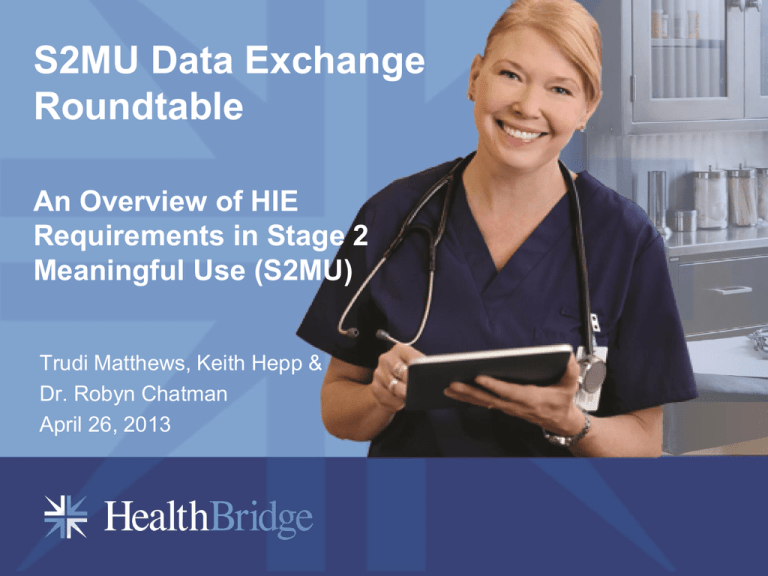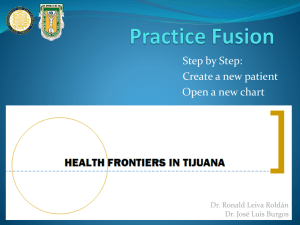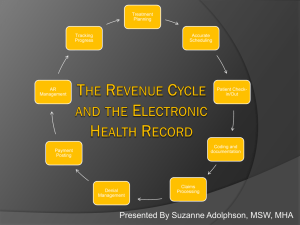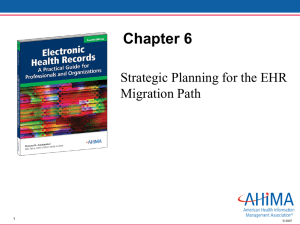
S2MU Data Exchange
Roundtable
An Overview of HIE
Requirements in Stage 2
Meaningful Use (S2MU)
Trudi Matthews, Keith Hepp &
Dr. Robyn Chatman
April 26, 2013
Overview
Background on HealthBridge
2
“Information is the lifeblood of medicine. We are only as powerful as the information
we have, whether we are a nurse practitioner, a physician, or a respiratory therapist.” - Dr.
David Blumenthal, former National Coordinator for Health Information Technology
If information is the lifeblood of medicine, our communication
methods make for a poor circulatory system.
Paper, mail and fax still dominant
methods for communication
• Information can be missing or hard to
find in paper charts.
• Nearly impossible to manage well a
whole population of patients.
Current methods for communication
not as secure
• Encryption not often used in health
care communications today
Sources: http://www.flickr.com/photos/dougww/922328173/
http://www.flickr.com/photos/greenlagirl/154148230/sizes/o/
http://www.flickr.com/photos/kenjonbro/3418425029/sizes/m/
3
HealthBridge Overview
• One of the nation’s largest, most advanced health
information exchange (HIE) organizations
• In operation since 1997 as a 501c3 Not for Profit
• Provide HIE services for Greater Cincinnati and four other
HIEs around the country
• Also operates the Tri-State REC and Cincinnati Beacon
Network Size =
•30+ hospitals,
•7500 Drs,
•800 practices,
•3+M patients
Data Connections:
−Sends 3-4 million messages PER MONTH
−Projected 60 million messages for 2012
−Connectivity with 40+ hospital information
systems
−Interfaces to 30+ different ambulatory EHR
systems
4
Summary of Services
Three Major HIT & HIE Service Areas:
1. IT Adoption & Meaningful Use (REC )
2. Connection & Exchange (HIE)
3. Innovation & Improvement Tools (Beacon)
5
Accelerating Practice Transformation
•Summit Family Physicians was a
paper-based practice in mid-2011.
• Tri-State REC helped with EHR
adoption, EHR live Sept. & attested in
December 2011.
•Collaborative helped them receive
PCMH Level 3 NCQA recognition.
•Practice was selected for the CMS
Comprehensive Primary Care
Initiative
Dr. Mark Fraser
and
Leah Brunie, ANP
of Summit Family
Physicians
“Having an EHR and all
the capabilities that it
provides has
revolutionized our
practice. We now run
reports that can identify
patients who are due
for such things as flu
shots or
mammograms.”
- Leah Brunie
Overview
Stage 2 Meaningful Use Requirements for HIE
7
Meaningful Use Stage 2 (S2MU)
• Final released August 23, 2012
• Attestation for Hospitals starts Oct. 31,2013
• Attestation for Professionals starts Jan. 1,
2014
• Builds on stage 1 with increased thresholds
• Actual exchange of information required
• Electronic access for patients
• Updates to quality measures to align with other
programs
8
Meaningful Use Stage 2 (S2MU)
S2MU final rules consist of two parts:
• CMS EHR Incentive Program Rule
• ONC Standards and Certification Criteria Rule (S&CC)
• Providers will need to pay attention to both in Stage 2.
• New Modular EHR certification in gives greater
flexibility to providers in meeting S2MU.
9
S2MU – Four Categories of HIE
•
•
•
•
Lab Exchange
Patient HIE
Transitions of Care
Public Health Exchange
S2 Meaningful Use – HIE in Red
EP Core Requirements (17)
• Computerized Provider Order Entry
• e-Prescribing
• Demographics
• Vital Signs
• Smoking Status
• Clinical Decision Support
• Lab Results (55%)
• Patient List
• Patient Preventative Reminders
• Patient Online Access
• Visit Summaries to Patient
• Secure Messages to Patients (5%)
• Rx Reconciliation
• Summary of Care (50% - 10%)
• Transmission of Immunizations (ongoing)
• Security Analysis
EP Menu Requirements (3 of 6)
• Imaging Results (20%)
• Family History
• Syndromic Surveillance
(ongoing)
• Cancer Case Information
(ongoing)
• Specialized Registry (ongoing)
• Progress Notes
EH HIE Requirements
• Core (same as EPs) – Lab
Results, Summary of Care,
Immunizations
• Core - Reportable Labs (ongoing)
• Core - Syndromic Surveillance
(ongoing)
• Menu – Lab Results to EPs (20%)
Both EP/EH Core
S2 MU HIE Requirements • Labs: Incorporate lab results for more than 55%
• Summary of Care: Provide summary of care
document for more than 50% of transitions of care and
referrals with 10% sent electronically and at least one
sent to a recipient with a different EHR vendor or
successfully testing with CMS test EHR
• Immunizations: Successful ongoing transmission of
immunization data
12
EP – EH Only Core
S2MU HIE Requirements
EP only
• Secure Messages: More than 5% of patients send
secure messages to their EP
EH only
• Reportable Labs: Successful ongoing submission of
reportable laboratory results
• Syndromic Surveillance: Successful ongoing
submission of electronic syndromic surveillance data
13
Big Deal: Transitions of Care
Summary
• Stage 2 requires that a provider send a summary of
care record for more than 50% of transitions of care
and referrals.
• The rule also requires that a provider electronically
transmit a summary of care for more than 10% of
transitions of care and referrals.
• At least one summary of care document sent
electronically to recipient with different EHR vendor or
to CMS test EHR.
14
New - 3 Options for “Certified EHR
Technology (CEHRT)”
• Complete EHR
• EHR Module(s):
–Combination of EHR Modules
–Single EHR Module
Main Point: It is now possible to choose and use
multiple technologies or applications to meet
the CEHRT definition.
Need Base EHR + MU Core + MU Menu + CQM
15
HB HIE Architecture
& Applications
An Overview
hbDirect – New Secure Email Service Using Direct
Public Health Connectivity
Dr. Crankshaw’s practice -– Family Physicians of
Urbana -- was one of two primary care
practices in southern Ohio that have
successfully tested sending immunization
records from their practice’s EHRs to the Ohio
ImpactSIIS Immunization registry.
“As a primary care practice, we are committed to
providing the best quality of care in a cost effective
way,” stated Dr. John Crankshaw, a physician with
Family Physicians of Urbana. “We want our patients to
receive the right vaccinations at the right time, and
have a clear record of their immunizations over time.”
20
21
Links to more information
• Tri-State REC S2MU Central: www.tristaterec.org/s2mu
• Stage 2 MU Overview: http://www.nationalehealth.org/how-play-final-rulesoverview-meaningful-use-stage-2-and-standards-and-certification-criteria-final-8
• S2MU HIE Matrix – from HIMSS:
http://www.himss.org/files/HIMSSorg/content/files/MU2_HIE_Matrix_FINAL.pdf
• ONC Interoperability Basics:
http://www.healthit.gov/Interoperability_Basics_Course_Web_Package_20130206/M/wrap
_menupage.htm
• Requirement Specific Spec Sheets from CMS on S2MU –
•
•
Hospitals: http://www.cms.gov/Regulations-andGuidance/Legislation/EHRIncentivePrograms/Downloads/Stage2_MeaningfulUseSpecSheet_TableContents_Eligi
bleHospitals_CAHs.pdf
EPs - http://www.cms.gov/Regulations-andGuidance/Legislation/EHRIncentivePrograms/Downloads/Stage2_MeaningfulUseSpecSheet_TableContents_EPs.
pdf
• S&I Companion Guide to S2MU Consolidated CDA
http://wiki.siframework.org/Companion+Guide+to+ Consolidated+CDA+for+MU2
22
Roundtable
Discussion
We want to hear from you.
• What was hard about the HIE requirements in Stage 1?
• What are you most concerned about HIE in Stage 2?
• How can we help?
23
S2MU Standards
and Certification
Criteria
Background Slides
24
Base EHR Requirements
25
Clinical Document Architecture (CDA)
and Templates
Clinical Document Architecture (CDA) is the base standard for
building electronic clinical documents for exchange
Templates apply CDA for a specific concept, such as a
diagnosis or hospital discharge summary
Templates are reusable and interchangeable “building
blocks” that can build a variety of clinical documents
To help simplify implementations, commonly used
templates were harmonized into a single implementation
guide – Consolidated CDA
26
How does C-CDA meet 2014 Ed. CEHRT
requirements?
CDA
standardizes the
expression of
clinical concepts
which can be
used/re-used
Templates are
used to specify
the ‘packaging’
for those clinical
concepts
Sets of CDA
templates are
arranged to
create a purposespecific clinical
document
2014 Ed. CEHRT
data requirements
can be captured
through
C-CDA templates
MU2
27
2014 Ed. CEHRT Data Requirements
Transition of Care Criterion
Criterion
Transition of Care
170.314(b)(1)&(2)
Description
Electronically create a transition
of care/referral summary
Common MU2 Data Set
Summary Type
Patient name
Sex
Date of birth
Race **
Ethnicity **
Preferred language
Care team member(s)
Allergies **
Medications **
Care plan
Problems **
Laboratory test(s) **
Laboratory value(s)/result(s) **
Procedures **
Smoking status **
Vital signs
Transition of Care/
Referral Summary
Objective-Specific Data Requirements
Provider Name & Office Contact Information
(Ambulatory Only)
Reason for Referral (Ambulatory Only)
Encounter Diagnoses **
Cognitive Status
Functional Status
Discharge Instructions (Inpatient Only)
Immunizations **
NOTE: Data requirements marked with a
double asterisk (**) also have a defined
vocabulary which must be used
28
Stage 2 Meaningful Use Standards – 5 Categories
Vocabulary
Content
Transport
Security
Services
(N/A in S2MU)
29
1. S2MU Vocabulary &
Code Sets
Standardized terms to describe clinical problems, procedures and other
clinical information coded for easy comprehension.
The following Vocabulary and Code Sets have been added to
Meaningful Use Stage 2:
Preferred Language (ISO 639-2),
Smoking Status (SNOMED CT – value set),
Medication Allergies (RxNorm),
Encounter Diagnosis (ICDEE-10-CM or SNOMED CT).
LOINC also continues from Stage 1
30
2. S2MU Content Structure
For MU Stage 2, the Content Structure has been
updated to include formatting for:
•
•
•
•
Lab Exchange: HL7 Version 2.5.1 Implementation
Guide (S&I Framework Lab Results Interface)
Summary Record: HL7 Implementation Guide for
Clinical Document Architecture (CDA®) Release 2:
IHE Health Story Consolidation (Consolidated CDA)
(Note: the use of the “unstructured document”
document level template is prohibited.)
Lab Reporting to Public Health: HL7 Version 2.5.1
Implementation Guide: Electronic Laboratory
Reporting to Public Health, Release 1 (US Realm)
Cancer Registry Reporting: CDA R2 + IG
31
3. S2MU Transport
Transport was not specified during MU Stage 1
Stage 2 consists of the following:
• Applicability Statement for Secure Health Transport
specification
• Applicability Statement for Secure Health Transport
specification and the XDR and XDM for Direct
Messaging specification (Optional)
• Simple Object Access Protocol (SOAP)-Based Secure
Transport Requirements Traceability Matrix (RTM)
version 1.0 standard and the XDR and XDM for Direct
Messaging specification (Optional).
32
CEHRT Criterion 170.314(b)(2) –
Transition of Care (Send)
• In order for a certification criterion to be met, all specific capabilities
expressed as part of it need to be demonstrated.
• For example, in 45 CFR 170.314(b)(2) there are two:
(i) Create CCDA with requisite data specified for MU
(ii) Enable a user to electronically transmit CCDA in accordance with:
(a) Direct (required)
(b) Direct +XDR/XDM (optional, not alternative)
(c) SOAP + XDR/XDM (optional, not alternative)
•
Thus, whatever EHR technology is presented for certification must
demonstrate compliance with both (i) and (ii) under (b)(2) to meet the
certification criterion.
•
This also means that there’s no certification for ‘transport only’ as part of
MUS2 / CEHRT 2014 Edition
Valid Certification Scenarios for EHR Technology
(Sending with Direct)
45 CFR 170.314(b)(2)
(i) Create CCDA with requisite data specified for MU
(ii) Enable a user to electronically transmit ToC in accordance with
Direct (or Direct +XDR/XDM; or SOAP + XDR/XDM)
Scenario 1
Whatever EHR technology is presented for certification must
demonstrate compliance with both (i) and (ii) under (b)(2) to meet
the certification criterion.
STA/HISP function
Provider A
Provider B integrated into EHRs;
1.EHR generates CCDA
2.EHR performs as STA
and sends Direct msg
no separate
certification testing for
HISP.
Direct (SMTP + S/MIME)
Complete EHR or EHR Module
certification issued.
Scenario 2
1.EHR sends “data” to
HISP
2.HISP generates CCDA
3.HISP performs as STA
and sends Direct msg
HISP
Provider A
Any
Edge
Provider B
HISP certified
independently as EHR
Module.
Direct (SMTP +
S/MIME)
Protocol
EHR Module certification issued
Scenario 3
1.EHR generates CCDA
2.EHR sends CCDA to
HISP
3.HISP performs as STA
and sends Direct msg
EHR Affiliated HISP
Provider A
Provider B
Any
Edge
Protocol
Direct (SMTP
+ S/MIME)
HISP certified as
“relied upon software”
with the EHR.
Certification given to
the pair, not EHR and
HISP separately.
Complete EHR or EHR Module
certification issued
What gets presented for certification
MU Transition of Care
• Measure #2: The eligible provider, eligible hospital or CAH that
transitions or refers their patient to another setting of care or provider of
care provides a summary of care record for more than 10 percent of
such transitions and referrals either:
• (a) electronically transmitted using CEHRT to a recipient, or
• (b) where the recipient receives the summary of care record via
exchange facilitated by an organization that is a NwHIN Exchange
participant or in a manner that is consistent with the governance
mechanism ONC establishes for the nationwide health information
network.
Approach #1 -- Send with CEHRT Required Transport:
Using Direct
Scenario 1
STA/HISP function
Provider A
Provider B integrated into EHRs;
1.EHR generates CCDA
2.EHR performs as STA
and sends Direct msg
no separate
certification testing for
HISP.
Direct (SMTP + S/MIME)
Complete EHR or EHR Module
certification issued.
Scenario 2
1.EHR sends “data” to
HISP
2.HISP generates CCDA
3.HISP performs as STA
and sends Direct msg
HISP
Provider A
Any
Edge
Provider B
HISP certified
independently as EHR
Module.
Direct (SMTP +
S/MIME)
Protocol
EHR Module certification issued
Scenario 3
1.EHR generates CCDA
2.EHR sends CCDA to
HISP
3.HISP performs as STA
and sends Direct msg
EHR Affiliated HISP
Provider A
Provider B
Any
Edge
Protocol
Direct (SMTP
+ S/MIME)
HISP certified as
“relied upon software”
with the EHR.
Certification given to
the pair, not EHR and
HISP separately.
Complete EHR or EHR Module
certification issued
CEHRT
Approach #2 -- Send with CEHRT Optional Transport:
SOAP + XD (Example)
Example #1
1.EHR generates CCDA
2.EHR (certified to
include optional SOAP +
XDR/XDM transport)
sends message to
Provider B using SOAP +
XDR/XDM
Provider A
Provider B
SOAP +
XDR/XDM
In this scenario, the
EHR must be certified
to support both Direct
(required) and SOAP
+ XDR/XDM (optional)
as transport
standards.
CEHRT
Note: This is one example of how a provider may use EHR technology
that has been certified to include optional transport standards. The
CEHRT could support a different optional transmission mechanism
(e.g., Direct + XDR/XDM). Also, as with the required Direct transport,
the CEHRT has architectural flexibility to use relied upon software in
their solution, seek modular certification, etc.
Approach #2 -- Send with CEHRT Optional Transport:
SOAP + XD via Intermediary (Example)
Example #2
1.EHR generates CCDA
2.EHR (certified to
include optional SOAP +
XDR/XDM transport)
sends message to
Provider B (via HISP)
using SOAP + XD
3.HISP repackages
content as Direct
message and sends to
Provider B
HISP
Provider A
Provider B
SOAP +
Direct (SMTP
+ S/MIME)
In this scenario, the
EHR must be certified
to support both Direct
(required) and SOAP
+ XDR/XDM (optional)
as transport
standards.
XDR/XDM
The HISP does not
need to be certified.
This meets the MU
requirement for using
CEHRT.
1.
Because Provider A is sending to Provider B using their CEHRT’s SOAP + XDR/XDM transport
CEHRT
option, the fact there’s a “HISP in the middle” is irrelevant with respect to Provider A meeting MU
requirements.
2.
This allows any EHR vendor supporting the SOAP + XDR/XDM option to interoperate with any
HISP that also offers SOAP + XDR/XDM support.
3.
Under this approach, HISPs do not have to be certified
4.
If EHRs implement SOAP/XD support and then partner with a HISP (i.e., use the HISP as relied
upon software for certification), they can also fulfill their Direct requirement under Scenario #3 with
minimal (or no) additional development/technical work on their part.
Approach #3 – Send via NwHIN Exchange
Participant
NwHIN Example
1.EHR generates CCDA
2.EHR sends CCDA to
NwHIN Exchange
Participant
3.NwHIN Exchange
Participant sends to
Provider B
Provider A
NwHIN Exchange Participant
(now eHealth Exchange)
Complete EHR or EHR
Provider B Module certification
issued.
NwHIN Exchange
participant does not
get certified.
CEHRT
CEHRT
Note: the regulation also permits an EP, eligible hospital, or CAH to
count in their numerator instances where a summary care record for
transitions of care or referrals was received via electronic exchange
facilitated in a manner consistent with the governance mechanism
ONC establishes for the nationwide health information network. ONC
has not yet established a governance mechanism for the nationwide
health information network. Until ONC establishes such a
governance mechanism, this specific option will not be available.









